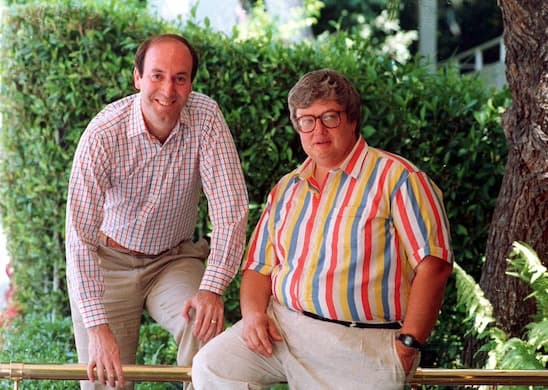Siskel and Ebert: How Two Talking Heads Made Movie Criticism Exciting
Before the two critics got together, television did not show clips of current films. The producers of ‘Siskel & Ebert’ actually had to get permission from Hollywood studios to edit clips to be used on the small screen.

‘Opposable Thumbs: How Siskel & Ebert Changed Movies Forever’
By Matt Singer
G. P. Putnam’s Sons, 352 pages
In 1975, two critics and bitter rivals — Gene Siskel at the Chicago Tribune and Roger Ebert at the Chicago Sun-Times — were coaxed into collaborating on a public television talking heads series about movies “coming to a theater near you” (the original title of their show). If you had grown up, as I did, without benefit of VCRs, let alone DVD players, cable, or streaming, “Siskel & Ebert” became an event, a drama of criticism that took no prisoners and suffered no fools.
The pilot for the program was a disaster. Neither critic knew how to address a television camera, but the television producers liked the passion of these adversaries, still in their 30s, and gradually the combatants learned to feed off one another’s animosity and occasional agreements, which could turn into arguments about why a film was good or bad.
Siskel and Ebert even argued about which name should come first after it was decided that earlier titles like “Sneak Previews” and “At the Movies” insufficiently promoted the brand the two men had developed. Ebert grudgingly conceded that “Ebert & Siskel” somehow did not have the same ring as the reverse. Gradually, he came to admire the highly competitive Siskel, who eventually showed Ebert considerable respect.
Both men came to realize that they had done something innovative on television and for film criticism. Before “Siskel & Ebert,” television did not show clips of current films. The producers of “Siskel & Ebert” actually had to get permission from Hollywood studios to edit clips to be used on the small screen.
Siskel and Ebert never faked it — that is, they did not argue for the sake of arguing. They did not socialize, and only in the very last of their 20-plus years together did they admit how much they relied on one another to create a brilliant model of criticism that would be imitated frequently after they left public television for commercial syndication.
“Siskel & Ebert” had its critics, as Matt Singer reports. Some believed the format demeaned criticism by making it a matter of a thumbs-up or thumbs-down entertainment. Yet as Mr. Singer rightly contends, the dialectic between two critics made criticism not a solitary but a thoughtful, communal experience suitable for other kinds of programming, including political talk shows.
Mr. Singer’s biography of these two men and of their show is frank, and quite moving. Siskel died of a brain tumor in 1999 at the age of 53. Ebert, suffering from many cancer operations that made him speechless but no less productive, died at 70 in 2013. How these two men chose to deal with their impending deaths is poignant — thanks to Mr. Singer’s deft narrative, which is helped by his interviews with the widows of Siskel and Ebert.
No review of a book about “Siskel & Ebert” would be complete without some griping. The Acknowledgements should be at the beginning of this book, not the end, because we need to know why Mr. Singer wrote the book, that he worked for Ebert after the demise of the “Siskel & Ebert” franchise, and that he believes these two critics changed how we view film — not passively but as a matter of hard-driving debate that is its own form of joy.
Also, don’t skip Mr. Singer’s Appendix, “Buried Treasures That Siskel & Ebert Loved.” Mr. Singer gets to do what might have damaged his book’s narrative: He reviews films in capsule form — as they might be reviewed on television — and this format allows him to show how Siskel and Ebert functioned as movie critics. Sometimes, Mr. Singer takes issue with their assessments. He points out that they could be quite enthusiastic about films that do not seem to have sustained subsequent attention — though he adds a proviso: “At least not yet.”
Newspapers now alert readers to new films, old films, classics, and contemporary hits that are in the theaters or streaming, but the newspaper assessments do not provide the kind of historical perspective to be found in Mr. Singer’s Appendix. Following his lead, I’m going to watch “Diva” (1981), a thriller I remember as indeed thrilling.
For many years Mr. Rollyson reviewed films for Magill’s Cinema Annual. His biography, “Ronald Colman: Hollywood’s Gentleman Hero,” will be published in June.

